

Close the Gap - COAG agreed targets. In 2008, COAG agreed to six ambitious targets to address the disadvantage faced by Indigenous Australians in life expectancy, child mortality, education and employment.
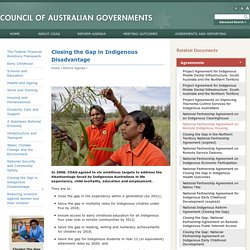
They are to: close the gap in life expectancy within a generation (by 2031);halve the gap in mortality rates for Indigenous children under five by 2018;ensure access to early childhood education for all Indigenous four year olds in remote communities by 2013;halve the gap in reading, writing and numeracy achievements for children by 2018;halve the gap for Indigenous students in Year 12 (or equivalent) attainment rates by 2020; andhalve the gap in employment outcomes between Indigenous and other Australians by 2018. Close the Gap 2016. Close the Gap 2015.
Vocational education is the 'weakling' of Australia's education system. A new report warns that vocational education is the "weakling" of Australian education, under threat from student exploitation, falling enrolments at government-funded providers, poor regulation and uncertainty about its future.

The federal and state governments should do a comprehensive national review of vocational education and training (VET) says the report, VET: Securing Skills for Growth, from the Committee for Economic Development of Australia. The review should include looking at how vocational education can better integrate with higher education, the report said. It said that governments needed to act because the "national partnership" agreement through which the federal government gives funding to states for vocational education ends in the middle of next year.
Last year the number of vocational education students funded by government fell by 12 per cent compared to 2014. Australian Primary School Scores. Department of Education and Training. All Australian governments have recommitted to the Closing the Gap targets under the National Indigenous Reform Agreement between the Australian Government and state and territory governments.
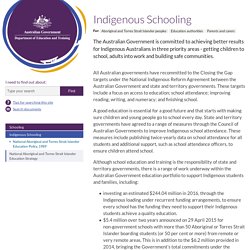
These targets include a focus on access to education; school attendance; improving reading, writing, and numeracy; and finishing school. A good education is essential for a good future and that starts with making sure children and young people go to school every day. State and territory governments have agreed to a range of measures through the Council of Australian Governments to improve Indigenous school attendance. These measures include publishing twice-yearly data on school attendance for all students and additional support, such as school attendance officers, to ensure children attend school. About Us - Australian Indigenous Education Foundation. The Australian Indigenous Education Foundation (AIEF) is a private sector-led, non-profit organisation focused on empowering Indigenous children in financial need to build a brighter future for themselves and for the nation.

AIEF provides scholarships that enable Indigenous students to attend leading Australian schools and universities, as well as mentoring and career support to ensure students make a successful transition from school to further studies or employment, productive careers and fulfilling lives. A product of a strong partnership between the Australian Government and the private sector, AIEF is building a $140 million fund to open the doors to leading schools and universities for 7,000 young Indigenous Australians.
AIEF provides scholarships and support through its two core programs, the AIEF Scholarship Program and the AIEF Pathways Program. The Model. The Gap: Indigenous Disadvantage in Australia. In 2008, the Australian government made a formal commitment to address Indigenous disadvantage in Australia, known as 'Closing the Gap', but what is the “gap”?
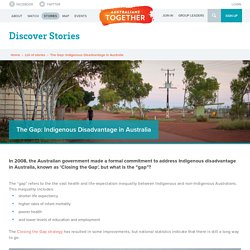
The “gap” refers to the the vast health and life-expectation inequality between Indigenous and non-Indigenous Australians. This inequality includes: shorter life expectancy higher rates of infant mortality poorer health and lower levels of education and employment The Closing the Gap strategy has resulted in some improvements, but national statistics indicate that there is still a long way to go. Indigenous Statistics for Schools. School Attendance Primary At the time of the 2006 Census, there were a total of 32,100 Indigenous children aged 3–5 years old.
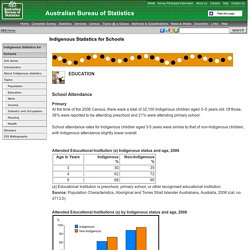
Of those, 36% were reported to be attending preschool and 21% were attending primary school. School attendance rates for Indigenous children aged 3-5 years were similar to that of non-Indigenous children, with Indigenous attendance slightly lower overall. Attended Educational Institution (a) Indigenous status and age, 2006 (a) Educational Institution is preschool, primary school, or other recognised educational institution.Source: Population Characteristics, Aboriginal and Torres Strait Islander Australians, Australia, 2006 (cat. no. 4713.0). Current priorities. The 2030 Agenda ACFID is focused on building support and understanding for the new Sustainable Development Goals and ensuring their integration into Australia’s aid and development policy.
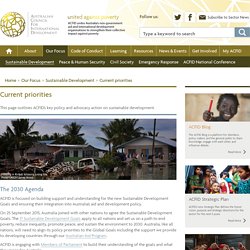
On 25 September 2015, Australia joined with other nations to agree the Sustainable Development Goals. Sustainable Development Goals for Australia Interim Report (Monash University) Fact check: Are young Indigenous men more likely to end up in jail than university? - Fact Check. Updated The claim "A young Aboriginal man of 18 in Australia is more likely to end up in jail than university," Opposition Leader Bill Shorten said in an interview on Sky News.

Overcoming Indigenous Disadvantage: Key Indicators 2014 - Overcoming Indigenous Disadvantage Productivity Commission. Fact sheet 7: Health outcomes for Aboriginal and Torres Strait Islander Australians Download this fact sheet Fact sheet 7: Health outcomes for Aboriginal and Torres Strait Islander Australians (PDF - 323 Kb) The Overcoming Indigenous Disadvantage (OID) report measures the wellbeing of Aboriginal and Torres Strait Islander Australians.
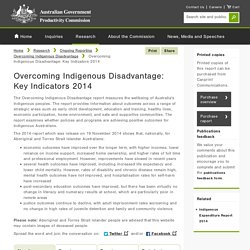
Sustainable development goals sustainable development solutions - Monash Sustainability Institute. About the initiative This initiative aims to support Australian and regional leadership in the development and implementation of the UN Sustainable Development Goals (SDGs).
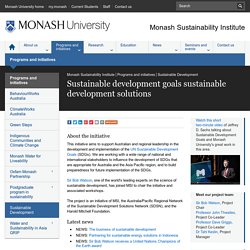
We are working with a wide range of national and international stakeholders to influence the development of SDGs that are appropriate for Australia and the Asia Pacific region, and to build preparedness for future implementation of the SDGs. Sir Bob Watson, one of the world's leading experts on the science of sustainable development, has joined MSI to chair the initiative and associated workshops. The project is an initiative of MSI, the Australia/Pacific Regional Network of the Sustainable Development Solutions Network (SDSN), and the Harold Mitchell Foundation.
Latest news. Global Compact Network Australia. In September 2015, the UN General Assembly adopted the Sustainable Development Goals (SDGs) – 17 global goals which lay out a path to 2030 to end extreme poverty, fight inequality and protect our planet. Business has a crucial role to play in achieving the SDGs – through responsible business operations, new business models, investment, innovation and technology, and collaboration. Further, the SDGs cover a broad range of issues relevant to companies – from poverty and inequality, to climate change – and engaging with the SDG agenda can help companies understand and link their strategies with global priorities. Global development. The 2030 Agenda for Sustainable Development The UN’s 193 member states formally agreed to the 2030 Agenda for Sustainable Development (the 2030 Agenda) on 25 September 2015 in New York. The new agenda provides a roadmap for global development efforts to 2030 and beyond. While non-binding, the 2030 Agenda will be highly influential, shaping development cooperation and finance flows from a range of sources, including nation states, multilateral organisations, the private sector and philanthropic entities.
Sustainable Development Goals. Australia ranks 20th on progress towards the Sustainable Development Goals. Australia may be home to some of the world’s most liveable cities, but we have a long way to go to meet the world’s Sustainable Development Goals (SDGs). Australia ranks 20th in the world – well behind Canada and many European countries but ahead of the United States – according to a new index that compares different nations' performance on the SDGs, which were adopted last September. Launched at this week’s United Nations SDG talks in New York, the index marks each country’s performance towards the 17 goals. These aim to put the world on a more sustainable economic, social and environmental path, and feature 169 targets to be met over the next 15 years in areas such as health, economic growth and climate action. The ranking, called the SDG Index and Dashboard and prepared by the UN Sustainable Development Solutions Network and the German think tank Bertelsmann Stiftung, ranks countries' performance using a set of 77 indicators.
Sustainable Development Goals: a win-win for Australia. On September 25 world leaders will meet in New York to formalise the new Sustainable Development Goals. These 17 goals will guide efforts to reduce poverty and increase well-being, without destroying the Earth. The Conversation is looking at how we got here, and how far we have to go. Unlike the Millennium Development Goals (or MDGs) that applied only to developing countries, the Sustainable Development Goals (or SDGs) will apply to all countries, including Australia. The new goals will have a key goal of eradicating extreme poverty, but they also have a much wider agenda.